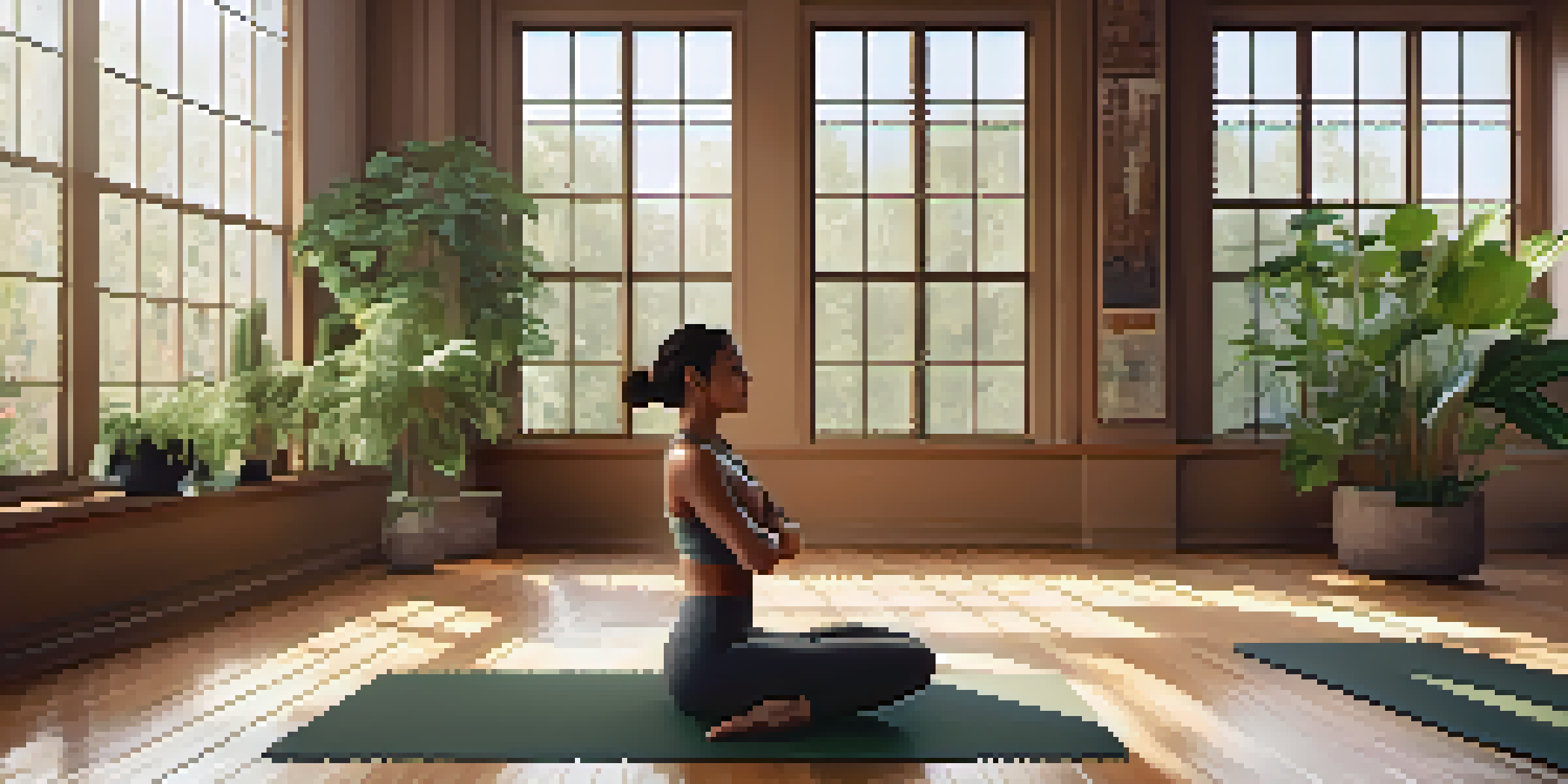Enhancing Strength and Flexibility: Yoga Poses for Fitness Gains

Understanding the Importance of Strength and Flexibility
Strength and flexibility are two cornerstones of overall fitness. While strength helps you perform daily tasks with ease, flexibility improves your range of motion and helps prevent injuries. Think of flexibility as the oil that keeps your body’s joints moving smoothly, while strength is the muscle that powers those movements.
Strength does not come from physical capacity. It comes from an indomitable will.
Incorporating both into your fitness routine can lead to balanced physical health. For instance, a strong body can benefit from the stretching and lengthening effects of yoga, which can enhance muscle recovery. This synergy between strength and flexibility is essential for athletes and fitness enthusiasts alike.
Moreover, yoga poses can be tailored to target specific muscle groups, providing a comprehensive workout. By understanding the relationship between these two elements, you can create a more effective fitness plan that promotes endurance, agility, and overall well-being.
Getting Started: Preparing for Your Yoga Journey
Before diving into yoga poses, it’s important to prepare your body and mind. Start with a proper warm-up to increase blood flow and reduce the risk of injury. Simple movements like neck rolls and shoulder shrugs can be very beneficial in easing tension and getting you ready for deeper stretches.

Setting an intention for your practice can also enhance your focus and commitment. Whether it’s to build strength, increase flexibility, or just find a moment of peace, having a clear goal can guide your session. Remember, yoga is as much about the mental aspect as it is about the physical.
Strength and Flexibility Matter
Combining strength and flexibility in your fitness routine enhances overall health and helps prevent injuries.
Lastly, consider your environment. Choose a quiet space with enough room to move freely, and gather any props you might need, like a yoga mat or blocks. Creating a conducive atmosphere can make a significant difference in how you connect with your practice.
Warrior I: A Strong Foundation for Strength
Warrior I is an iconic yoga pose that builds strength in the legs, core, and arms. To perform this pose, start in a standing position, step back with one foot, and bend the front knee while reaching your arms overhead. This pose not only strengthens your muscles but also improves your stamina and balance.
Flexibility is the key to stability.
The grounding nature of Warrior I helps you cultivate focus and determination. Imagine you’re a warrior, ready to face any challenge that comes your way. This mindset can boost your confidence both on and off the mat.
Additionally, Warrior I stretches the hip flexors and chest, opening up your body for deeper breathing. This combination of strength and flexibility makes it a perfect addition to any fitness routine. Plus, it’s a great reminder of your inner strength!
Downward Dog: A Classic for Flexibility and Strength
Downward Dog is not just a resting pose; it’s a powerful tool for building strength and flexibility. In this position, your body forms an inverted V, which stretches your hamstrings, calves, and spine. It’s like a full-body stretch that rejuvenates you while also working your arms and shoulders.
This pose encourages blood flow to the brain, providing a refreshing boost of energy. Think of it as a mini recharge for your mind and body. By holding Downward Dog, you’re strengthening your upper body and improving your overall posture.
Yoga Prepares Body and Mind
A proper warm-up and setting intentions can significantly improve your yoga practice and mental focus.
Incorporating Downward Dog into your routine can also alleviate tension in the lower back. By consistently practicing this pose, you can enhance your overall flexibility, making it easier to transition into more challenging poses as your practice evolves.
Cobra Pose: Building Back Strength and Flexibility
Cobra Pose is an excellent way to strengthen the back while promoting flexibility in the spine. As you lie on your stomach and lift your chest upward, you engage your back muscles and open up your heart. This action not only builds strength but also encourages a sense of openness and vulnerability.
This pose can be particularly beneficial for those who spend long hours sitting, as it counteracts the effects of poor posture. By stretching the front of your body and strengthening the back, you create a balance that enhances your overall alignment.
As you practice Cobra Pose, focus on your breath, allowing it to guide your movements. This connection between breath and movement fosters a deeper understanding of your body, making your practice more fulfilling and enjoyable.
Tree Pose: Strengthening Balance and Core Stability
Tree Pose is a fantastic way to improve your balance while strengthening your legs and core. Standing on one leg and placing the other foot against your inner thigh or calf challenges your stability and encourages focus. Picture yourself as a sturdy tree, rooted firmly in the ground while reaching for the sky.
Practicing Tree Pose regularly can lead to improved coordination and core strength. The engagement of your core muscles not only supports your balance but can also enhance your overall athletic performance. This pose teaches patience and perseverance, both essential qualities in fitness and life.
Integrate Yoga for Better Fitness
Incorporating yoga into your existing fitness routine can enhance performance, recovery, and overall well-being.
Moreover, Tree Pose stretches the groin and inner thigh, promoting flexibility in the lower body. By integrating this pose into your routine, you’ll notice a greater sense of stability and confidence in your movements.
Bridge Pose: Combining Strength and Stretch for the Back
Bridge Pose is a wonderful way to strengthen the back, glutes, and legs while also opening the chest and hip flexors. As you lift your hips off the ground, you create a natural arch in your back that promotes flexibility. This pose is like a gentle bridge connecting strength to flexibility in your body.
This pose can also alleviate tension in the lower back, making it an excellent choice for those with desk jobs or sedentary lifestyles. By regularly practicing Bridge Pose, you can counteract the effects of prolonged sitting and enhance your overall posture.

Additionally, Bridge Pose encourages deep breathing, which further enhances relaxation and stress relief. It’s a reminder to take a moment for yourself, finding strength in stillness while also promoting physical health.
Finding Balance: Integrating Yoga into Your Fitness Routine
The beauty of yoga lies in its versatility; you can seamlessly integrate it into your existing fitness routine. Combining yoga with strength training or cardio can enhance your overall performance and recovery. For instance, practicing yoga after a workout can help stretch sore muscles and prevent tightness.
Consider dedicating specific days to yoga or incorporating shorter sessions into your daily routine. Even a few minutes of yoga can make a significant difference in your flexibility and strength. Think of it as a delicious side dish that complements your main course of workouts.
Ultimately, finding the right balance between strength training, cardio, and yoga will lead to a more well-rounded fitness journey. By embracing all aspects of fitness, you can achieve better results and enjoy the process along the way.